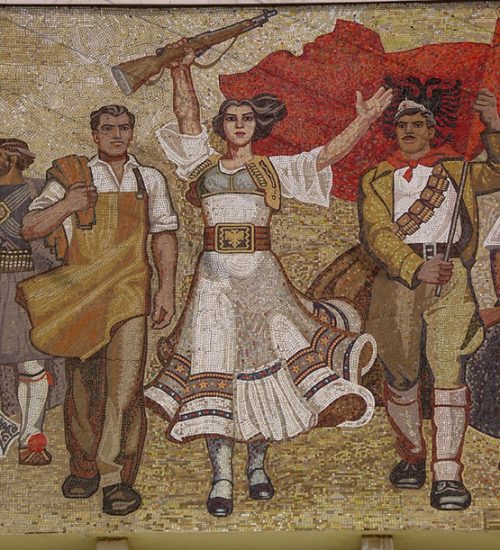Major Cities and attractions
- Home
- Major Cities and attractions
TIRANA – the capital
Tirana was proclaimed the capital of Albania relatively late, in 1920. Its beginning as a city can be traced back to 1614 when a local feudal nobleman Sulejman Bargjini, build some simple civic infrastructure such as a mosque and public hammam. However, discoveries of fortifications in the central area of the city as well as a Roman Villa with mosaics from the 3 rd century AD, are clear testimony of Tirana’s much earlier beginnings. The city began its growth at the beginning of the 18th century with population from other areas converging to Tirana due to its central position. Today with almost 1/3 rd of the country’s population, Tirana is not only the most populated city in Albania, but also the political and economic heart of the country. The Adriatic Sea and Dajti mountain are very close, giving this capital access to the sea or mountain in around 45 minutes. A large park with an artificial lake is located in the south part of the city.

What to visit in Tirana
- The Mosque of Ethem Bey: The symbol of Tirana is situated just off the main Scanderbeg Square. It was constructed in 1789. Together with the Clock Tower (1830) they make an important historic part of Tirana.
- Central Tirana architectural styles: The Ministerial buildings, the main boulevard, stadium, University building were built in the 1920s and 30s by Italian architects and represent the modern development of Tirana as a city. After the Second World War several buildings were erected in a communist architecture such as: The Palace of Culture, The Palace of Congresses, The National Historic Museum, The Dictators Pyramid being converted into Youth Centre for Cultural & Technology etc.
- Ura Tabakeve – Tabakeve Bridge: This is an arched stone bridge constructed in the 18 th century and is situated not far from the main square, along the boulevard “Zhan Dark”.
- The fortress of Pertrela: Located at south of Tirana on the right side of national road linking the capital with the city of Elbasan. It was built up by the middle age. The castle was under the command of Scanderbeg sister, Mamica Kastrioti. Petrela castle used to control the Egnatia road, the Durres - Tirane branch, a part that for that time had a particular importance. This castle was also part of a smoke signalling defence system for the castle of Kruja.
- The fortress of Preza: Built in the 15 th century it is in a dominant hill over the fields below and directly opposite the mountain of Kruja, forming the last signalling point for enemies approaching Kruja Castle from the fields below. It has been declared a "Monument of Culture"
- The Tomb of Kapllan Pasha: It was built in 1814 to honour Kaplan Pasha, who ruled Tirana in the early 19th century.
- Museums:
o National Historic Museum
o Archaeological Museum
o Gallery of Fine Arts
o Bunkart 1 & 2 (huge underground bunkers turned museums)
o House of Leaves museum of survelliance
BERAT
This UNESCO protected town is one of the most attractive traditional Albanian towns, declared a museum city. Know also as “the town of one-thousand windows”, it is situated on the slopes of two mirroring hills divided by the Osum River. The still inhabited fortress rises in a predominant hill. Inside its walls is located the “Onufri Museum”. Paintings and icons by the outstanding Albanian painter are also exhibited there. The old part of the city has some religious buildings like churches and mosques.
What to visit in Berat
DURRES
The principal port of Durres is the second largest city of Albania. The city was colonized by the colonists from Corinth and Korkyra in 627 B.C. It was named Epidamnus, which later became Dyrrachium. The most important object is the amphitheatre, the largest in Balkan with 15,000 seats, dating back to the 2nd century AD and containing an Early Christian crypt with a rare wall mosaics . Between the 1st and 3rd centuries Durres was an important port and trading centre on the Via Egnatia trading route, between Rome and Byzantuim (Istanbul). After a great number of earthquakes, much of ancient Durres sank into the sea or collapsed and was subsequently built over. Today the city is well known for the nearby beach resort of Durres and its sandy beaches and warm sea waters.
What to visit in Durres
FIER
One of the largest cities in Albania Fier was developed as an industrial city during the 45 years of communism dictatorship. However this city boasts with some very important historical sites.
What to visit in Fier region
GJIROKASTRA
One of the most important cities of southern Albania has been declared a “Museum City”. It is built on the slope of a mountain and is known for its characteristic and narrow stone paved streets. The dwelling houses have the form of medieval towers consisting a building ensemble with characteristic architecture. The castle of the city stands like a balcony over the city. It nables the visitors to enjoy a very beautiful landscape. The National Museum of Weapons is housed in the interior of the castle. Weapons are produced and used by the Albanian since the ancient times are displayed there.
What to visit in Gjirokastra
KORCA
Is the largest city of south eastern part of Albania. It is situated at the foot of Morava Mountain on a plateau 800 m above sea level. It became an important trading and handicraft centre in the 18th century due to the development of trade with neighbouring regions. The museum for Medieval Art is in Korça. It presents the spiritual and material culture of the Albanian people. There are also the Museum of Education, where the first Albanian School were opened in 1878 and the new museum of “Bratko Collections” with antiquaries from the Far East.
What to visit in Korca
KRUJA
Kruja is a medieval town near Tirana. The name of Kruja is closely connected with the name of the National Hero , George Kastriot Scanderbeg, who fought against the Ottomans for 25 years in succession, defending European civilization from their threat in the 15th century. At a prominent and strategic place near the city, there is a castle, within is housed the Scanderbeg Museum (National Museum). On the way to the castle there is a medieval bazaar.
Kruja attractions
POGRADEC
Pogradec is one of the most charming tourist resorts in Albania because of its position on Lake Ohrid which distinguishes itself for clear water and mountain views. The Koran fish, similar to trout, is found in this lake. Besides the beautiful beach, your stay in Pogradec is made more interesting by the excursion to the tourist centre in Driloni (5 km eastward) surrounded by ornamental plants and trees.
What to visit in Pogradec
SARANDA
Saranda is most southern city of Albania. Situated opposite of Corfu Island , Saranda is now mostly visited by day trippers who come to enjoy this previously inaccessible resort. It is one of the most tourist sites in Albania and is very preferable by “honeymooners”. Near Saranda there are the ruins of the ancient city of Butrint and the spring of “Blue Eye”.
What to visit in Saranda
SHKODRA
It is one of the most major cities in the north – western part of the country. It is situated near the lake sharing the same name and along the road that leads to Montenegro. It is an ancient city with rich history. One can find old characteristic houses where wood and other traditional motifs are used. Near the city there is the castle of Rozafa built on a rocky hill from where you can see attractive and beautiful views. During your stay you can visit the Historical Museum of the city. Shkodra is a good point to start your trip to Albanian Alps.
What to visit in Shkodra
On the way from Tirana to Shkodra in the town of Lezha is interesting to visit the memorial
dedicated to burial place of Albanian National Hero, Scanderbeg.
VLORA
Vlora is a coastal city situated in the horseshoe bay with the same name. It is a town of great historical importance as it was here that in 1912 the Assembly was convened to proclaim Albania as an independent state and to set up the first National Government headed by Ismail Qemali. Thus, Vlore became the first capital city of an independent Albania. One can learn more about the background of this event at the Museum of Independence. On a hill above the city one can enjoy the religious place of “Kuzum Baba”. From there you can see the beach and the view of the whole city.
What to visit in Vlora region
Informations
- © 2025 Fine Travel Albania DMC | Powered By WebHiper
